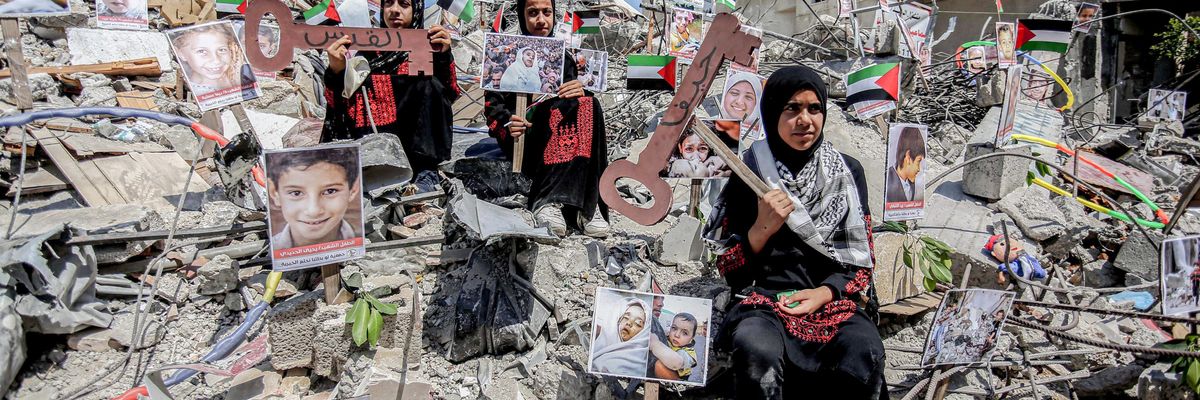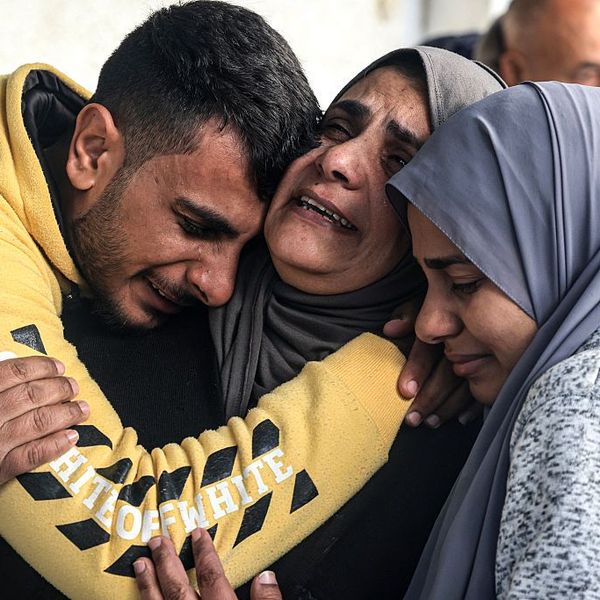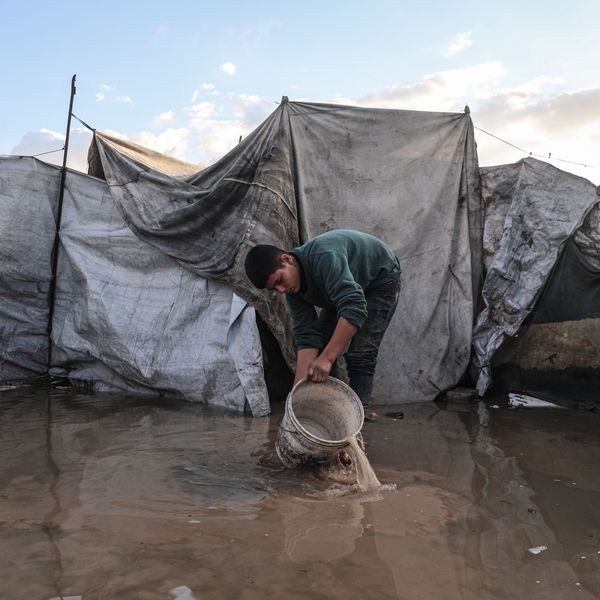
Palestinian youths sit next to the pictures of children who lost their lives in the May 2021 Israeli assault on Gaza. The photos were placed above the rubble of the Sakka family home in Khan Yunis, Gaza on June 19, 2021. (Photo: Yousef Masoud/SOPA Images/LightRocket via Getty Images)
New Interactive Map Gives Ground-Level Look at High Civilian Toll of Israel's Gaza War
"Our latest study corroborates what we have found with other large-scale conflicts in Iraq, Syria, and elsewhere: Even technologically advanced militaries kill large numbers of civilians when attacks focus on urban centers."
A new report and interactive map published Thursday by a leading airstrike monitoring organization offer detailed insight into incidents of civilian harm caused by Israel Defense Forces' aerial bombardment of Gaza during the May 2021 Operation Guardian of the Walls assault on the Palestinian territory, as well as casualties resulting from militant rocket attacks on Israel.
"Despite repeated assurances to the contrary, it's clear that 'precision warfare' cannot sufficiently mitigate civilian harm."
The report--entitled "Why Did They Bomb Us?" Urban Civilian Harm in Gaza, Syria, and Israel From Explosive Weapons Use--was published by the U.K.-based airstrike watchdog Airwars. The group said the publication "comprehensively documents the civilian toll of recent Israeli actions in Gaza and Syria, as well as from Palestinian rocket fire into Israel" during the 15-day war.
The report's interactive map shows neighborhood-level data--including names, ages, relations, and locations--and allows users to navigate through 128 separate incidents of civilian harm in Gaza.
"Our latest study corroborates what we have found with other large-scale conflicts in Iraq, Syria, and elsewhere: Even technologically advanced militaries kill large numbers of civilians when attacks focus on urban centers," Airwars director Chris Woods said in a statement. "Despite repeated assurances to the contrary, it's clear that 'precision warfare' cannot sufficiently mitigate civilian harm."
\u201cMore than 150 Palestinian civilians died in 11 days in May this year.\n\nThis interactive mapping, the result of six months research by my brilliant @airwars colleagues, is meant as a lasting testament to the human toll of that devastating conflict\n\nhttps://t.co/NZ2Gy9zY85\u201d— Joe (@Joe) 1639042603
"Stark differences in civilian deaths and injuries from Israeli actions in Syria and in the Gaza Strip clearly illustrate that the most significant driver of civilian harm remains the use of explosive weapons in populated areas," Woods continued.
Earlier this year, Common Dreams reported on a study by Action on Armed Violence that found 91% of people killed or injured when explosive weapons were used in populated areas worldwide from 2011 to 2020 were civilians.
"The single most effective way to reduce the number of civilians dying in warfare would be to restrict the use of such dangerous wide area-effect weapons on urban centers," Woods added.
\u201cWhy did Israeli strikes in Gaza kill so many civilians?\u201d— Airwars (@Airwars) 1639042200
Among the report's key findings:
- Across the three conflict areas, both the targeting approach and the population density of those areas bombed were critical drivers of civilian harm, leading to profoundly different outcomes for civilians;
- In Gaza between 151 and 192 civilians were likely killed as a result of IDF actions in May 2021, mostly in densely populated areas, with at least one-third of those killed being children;
- Between 15 and 20 civilian deaths in Gaza were additionally likely to have resulted from Palestinian rocket misfires;
- Ten civilians were directly killed in Israel in May 2021 resulting from Palestinian militant actions, with most casualties occurring when rockets penetrated Israel's Iron Dome missile defense system and reached cities and towns; and
- By comparison, an extensive eight-year IDF bombing campaign in Syria has had a far lower death toll--killing at least 14 and up to 40 civilians--due to a focus on exclusively military targets away from population centers.
The new report and map come days after United Nations High Commissioner for Human Rights Michelle Bachelet warned that conditions in Gaza "can fairly be characterized as disastrous."
"Severe movement restrictions and obstructions to people's access to essential goods and services, including specialized healthcare, generate immense suffering," she said amid the ongoing Covid-19 pandemic. "Only an end to the occupation can bring about lasting peace and establish the conditions in which the human rights of all can be fully respected."
An Urgent Message From Our Co-Founder
Dear Common Dreams reader, The U.S. is on a fast track to authoritarianism like nothing I've ever seen. Meanwhile, corporate news outlets are utterly capitulating to Trump, twisting their coverage to avoid drawing his ire while lining up to stuff cash in his pockets. That's why I believe that Common Dreams is doing the best and most consequential reporting that we've ever done. Our small but mighty team is a progressive reporting powerhouse, covering the news every day that the corporate media never will. Our mission has always been simple: To inform. To inspire. And to ignite change for the common good. Now here's the key piece that I want all our readers to understand: None of this would be possible without your financial support. That's not just some fundraising cliche. It's the absolute and literal truth. We don't accept corporate advertising and never will. We don't have a paywall because we don't think people should be blocked from critical news based on their ability to pay. Everything we do is funded by the donations of readers like you. Will you donate now to help power the nonprofit, independent reporting of Common Dreams? Thank you for being a vital member of our community. Together, we can keep independent journalism alive when it’s needed most. - Craig Brown, Co-founder |
A new report and interactive map published Thursday by a leading airstrike monitoring organization offer detailed insight into incidents of civilian harm caused by Israel Defense Forces' aerial bombardment of Gaza during the May 2021 Operation Guardian of the Walls assault on the Palestinian territory, as well as casualties resulting from militant rocket attacks on Israel.
"Despite repeated assurances to the contrary, it's clear that 'precision warfare' cannot sufficiently mitigate civilian harm."
The report--entitled "Why Did They Bomb Us?" Urban Civilian Harm in Gaza, Syria, and Israel From Explosive Weapons Use--was published by the U.K.-based airstrike watchdog Airwars. The group said the publication "comprehensively documents the civilian toll of recent Israeli actions in Gaza and Syria, as well as from Palestinian rocket fire into Israel" during the 15-day war.
The report's interactive map shows neighborhood-level data--including names, ages, relations, and locations--and allows users to navigate through 128 separate incidents of civilian harm in Gaza.
"Our latest study corroborates what we have found with other large-scale conflicts in Iraq, Syria, and elsewhere: Even technologically advanced militaries kill large numbers of civilians when attacks focus on urban centers," Airwars director Chris Woods said in a statement. "Despite repeated assurances to the contrary, it's clear that 'precision warfare' cannot sufficiently mitigate civilian harm."
\u201cMore than 150 Palestinian civilians died in 11 days in May this year.\n\nThis interactive mapping, the result of six months research by my brilliant @airwars colleagues, is meant as a lasting testament to the human toll of that devastating conflict\n\nhttps://t.co/NZ2Gy9zY85\u201d— Joe (@Joe) 1639042603
"Stark differences in civilian deaths and injuries from Israeli actions in Syria and in the Gaza Strip clearly illustrate that the most significant driver of civilian harm remains the use of explosive weapons in populated areas," Woods continued.
Earlier this year, Common Dreams reported on a study by Action on Armed Violence that found 91% of people killed or injured when explosive weapons were used in populated areas worldwide from 2011 to 2020 were civilians.
"The single most effective way to reduce the number of civilians dying in warfare would be to restrict the use of such dangerous wide area-effect weapons on urban centers," Woods added.
\u201cWhy did Israeli strikes in Gaza kill so many civilians?\u201d— Airwars (@Airwars) 1639042200
Among the report's key findings:
- Across the three conflict areas, both the targeting approach and the population density of those areas bombed were critical drivers of civilian harm, leading to profoundly different outcomes for civilians;
- In Gaza between 151 and 192 civilians were likely killed as a result of IDF actions in May 2021, mostly in densely populated areas, with at least one-third of those killed being children;
- Between 15 and 20 civilian deaths in Gaza were additionally likely to have resulted from Palestinian rocket misfires;
- Ten civilians were directly killed in Israel in May 2021 resulting from Palestinian militant actions, with most casualties occurring when rockets penetrated Israel's Iron Dome missile defense system and reached cities and towns; and
- By comparison, an extensive eight-year IDF bombing campaign in Syria has had a far lower death toll--killing at least 14 and up to 40 civilians--due to a focus on exclusively military targets away from population centers.
The new report and map come days after United Nations High Commissioner for Human Rights Michelle Bachelet warned that conditions in Gaza "can fairly be characterized as disastrous."
"Severe movement restrictions and obstructions to people's access to essential goods and services, including specialized healthcare, generate immense suffering," she said amid the ongoing Covid-19 pandemic. "Only an end to the occupation can bring about lasting peace and establish the conditions in which the human rights of all can be fully respected."
A new report and interactive map published Thursday by a leading airstrike monitoring organization offer detailed insight into incidents of civilian harm caused by Israel Defense Forces' aerial bombardment of Gaza during the May 2021 Operation Guardian of the Walls assault on the Palestinian territory, as well as casualties resulting from militant rocket attacks on Israel.
"Despite repeated assurances to the contrary, it's clear that 'precision warfare' cannot sufficiently mitigate civilian harm."
The report--entitled "Why Did They Bomb Us?" Urban Civilian Harm in Gaza, Syria, and Israel From Explosive Weapons Use--was published by the U.K.-based airstrike watchdog Airwars. The group said the publication "comprehensively documents the civilian toll of recent Israeli actions in Gaza and Syria, as well as from Palestinian rocket fire into Israel" during the 15-day war.
The report's interactive map shows neighborhood-level data--including names, ages, relations, and locations--and allows users to navigate through 128 separate incidents of civilian harm in Gaza.
"Our latest study corroborates what we have found with other large-scale conflicts in Iraq, Syria, and elsewhere: Even technologically advanced militaries kill large numbers of civilians when attacks focus on urban centers," Airwars director Chris Woods said in a statement. "Despite repeated assurances to the contrary, it's clear that 'precision warfare' cannot sufficiently mitigate civilian harm."
\u201cMore than 150 Palestinian civilians died in 11 days in May this year.\n\nThis interactive mapping, the result of six months research by my brilliant @airwars colleagues, is meant as a lasting testament to the human toll of that devastating conflict\n\nhttps://t.co/NZ2Gy9zY85\u201d— Joe (@Joe) 1639042603
"Stark differences in civilian deaths and injuries from Israeli actions in Syria and in the Gaza Strip clearly illustrate that the most significant driver of civilian harm remains the use of explosive weapons in populated areas," Woods continued.
Earlier this year, Common Dreams reported on a study by Action on Armed Violence that found 91% of people killed or injured when explosive weapons were used in populated areas worldwide from 2011 to 2020 were civilians.
"The single most effective way to reduce the number of civilians dying in warfare would be to restrict the use of such dangerous wide area-effect weapons on urban centers," Woods added.
\u201cWhy did Israeli strikes in Gaza kill so many civilians?\u201d— Airwars (@Airwars) 1639042200
Among the report's key findings:
- Across the three conflict areas, both the targeting approach and the population density of those areas bombed were critical drivers of civilian harm, leading to profoundly different outcomes for civilians;
- In Gaza between 151 and 192 civilians were likely killed as a result of IDF actions in May 2021, mostly in densely populated areas, with at least one-third of those killed being children;
- Between 15 and 20 civilian deaths in Gaza were additionally likely to have resulted from Palestinian rocket misfires;
- Ten civilians were directly killed in Israel in May 2021 resulting from Palestinian militant actions, with most casualties occurring when rockets penetrated Israel's Iron Dome missile defense system and reached cities and towns; and
- By comparison, an extensive eight-year IDF bombing campaign in Syria has had a far lower death toll--killing at least 14 and up to 40 civilians--due to a focus on exclusively military targets away from population centers.
The new report and map come days after United Nations High Commissioner for Human Rights Michelle Bachelet warned that conditions in Gaza "can fairly be characterized as disastrous."
"Severe movement restrictions and obstructions to people's access to essential goods and services, including specialized healthcare, generate immense suffering," she said amid the ongoing Covid-19 pandemic. "Only an end to the occupation can bring about lasting peace and establish the conditions in which the human rights of all can be fully respected."

